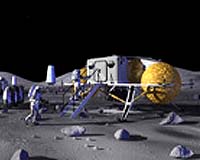 |
Raleigh NC (SPX) May 20, 2009 Alien creatures are the least of NASA's worries when it comes to moon travel. There are several potential threats to future missions - with space radiation at the top of the list. The surface of the moon is exposed to cosmic rays and solar flares - making radiation hard to stop with shielding. When these rays hit matter, they produce a dangerous spray of secondary particles which, when penetrating human flesh, can damage DNA, boosting the risk of cancer and other maladies. Astronauts who previously traveled to the moon had little protection against radiation, but were only exposed to it for a short amount of time. NASA's plans to return astronauts to the moon by 2020 - and to potentially keep them there for several months at a time - could be stymied by space radiation. Now, groups all over the globe are trying to determine ways to combat space radiation - including a group of students in North Carolina State University's College of Textiles. Their work is part of a competition held by the Revolutionary Aerospace Systems Concepts Academic Linkage (RASC-AL) - which is sponsored by NASA and National Institute of Aerospace. The contest challenges university students to think about what sorts of conditions astronauts will face when returning to the moon, then design projects that may become part of actual lunar exploration. Michael Sieber, Ryan Boyle and Anne Tomasevich - all recent graduates of the textile engineering program at NC State - decided to participate in the RASC-AL competition as part of their senior capstone class. Their design of a lunar radiation shield with the ability to protect its inhabitants from radiation was reviewed by a panel of industry experts and chosen as one of 10 undergraduate abstracts accepted by RASC-AL. They call their design the lunar texshield - a "blanket" of sorts that covers the lunar outpost and has the ability to provide astronauts protection against radiation, while also generating and storing power. Don't let the blanket reference fool you - this is more "Star Trek" than "Snuggie." "We had many factors to consider in developing this outpost cover - not just being able to protect against radiation," Sieber said. "The product needed to be as lightweight as possible to feasibly fit on the transportation module, and have the ability to be easily erected by a minimum number of astronauts for immediate use once landing on the moon." "These obstacles are where our knowledge of textile properties will give us an advantage," added Dr. Warren Jasper, professor of textile engineering and advisor for the project. "This is a competition aimed at aerospace engineering students, but we understand the properties associated with different textile materials, and that gives us unique insight on how to troubleshoot some of these issues." The lunar texshield is made from a lightweight polymer material that has a layer of radiation shielding that deflects or absorbs the radiation so astronauts are only exposed to a safe amount. The outermost surface of the shield includes a layer of solar cells to generate electricity, backed up by layers of radiation absorbing materials. The advantages of the materials used include flexibility, large surface area, ease of transportation, ease of construction and the ability to have multiple layers of independent functional fabrics. The students will present their lunar texshield at the 2009 RASC-AL Forum held June 1-3 in Cocoa Beach, Fla. The project will be judged by a steering committee is made up of experts from NASA, industry and universities. "We aren't even sure what the prize is for being named first place - but that wasn't what was important to us," Sieber said. "We used what we've learned throughout our college careers and were able to apply that logic to provide a solution a real-world problem. That's what is cool to us." Share This Article With Planet Earth
Related Links College of Textiles at NCSU Space Tourism, Space Transport and Space Exploration News
 Protecting Lunar Outposts From Dangerous Radiation
Protecting Lunar Outposts From Dangerous RadiationRaleigh NC (SPX) May 13, 2009 Alien creatures are the least of NASA's worries when it comes to moon travel. There are several potential threats to future missions - with space radiation at the top of the list. Now, a group of students at North Carolina State University has developed a "blanket" of sorts that covers lunar outposts - the astronauts' living quarters - to provide astronauts protection against radiation whi ... read more |
|
| The content herein, unless otherwise known to be public domain, are Copyright 1995-2009 - SpaceDaily. AFP and UPI Wire Stories are copyright Agence France-Presse and United Press International. ESA Portal Reports are copyright European Space Agency. All NASA sourced material is public domain. Additional copyrights may apply in whole or part to other bona fide parties. Advertising does not imply endorsement,agreement or approval of any opinions, statements or information provided by SpaceDaily on any Web page published or hosted by SpaceDaily. Privacy Statement |